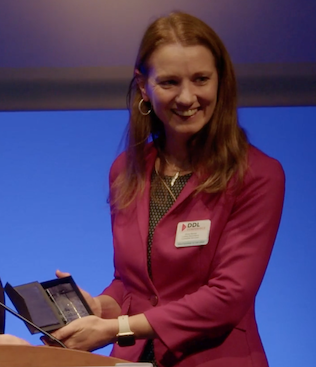In conclusion, Traini said, “I really think we are trying to look at the way we do pre-clinical testing . . . like if the body is a gigantic jigsaw puzzle with 3 million pieces, and we’re trying to look at one piece at a time, or maybe 2 pieces that are connected to each other. . . . We probably now need to make a shift in the way we work and actually make use of these novel and technologically-advanced nonclinical tests to try to look at the body as one big piece, even if it is a very complex piece.”
Following Traini’s lecture, José Sánchez of AstraZeneca spoke about “The impact of Data science and artificial intelligence in the pharmaceutical industry,” presenting an overview of how artificial intelligence works and how it can work for in pharmaceutical development, including in generating targets and making clinical trials more efficient. “AI is advancing in all possible areas, not only in drug development, . . . and it’s advancing at a very, very fast pace, and the ethical development around it is not necessarily developing at the same pace.”
Novel formulation strategies
DDL 2023 Emerging Scientist Award award winner Olivia Merkel of Ludwig-Maximilians-Universität München, provided an example of AI-assisted development in a lecture describing her work in inhaled delivery of RNA. Merkel described her development of nanocarriers for inhaled delivery of siRNA to T cells in order to down-regulate production of GATA-3, “the conductor of an orchestra of inflammation,” in order to reduce the production of cytokines. She described using a human ex vivo model to perform transfection and toxicity studies and creating a spray dried nano-in-microparticle dry powder formulation of the siRNA using a polyethylene imine nanocarrier.
Because the original nanocarriers were not biodegradable, she is working to design a biodegradable nanocarrier using oligospermines. As part of this process, she evaluates a range of amphiphilic materials with different sizes and different ratios of cationic and hydrophobic side chains using molecular dynamics (MD) simulations. The MD simulations, she explained, help them to decide which materials to synthesize for use in training and validation of their formulation AI. Some of the resulting siRNA formulations have demonstrated efficient down-regulation of collagen production in ex vivo testing using lungs from patients with lung fibrosis, she reported.
Merkel concluded by saying that she sees a much larger role for the use of AI and non-animal models in the development of formulations for inhaled RNA therapy as well as greater role for that type of therapy in the future.
Several other speakers also described projects related to delivery of RNA to the lung. In the Novel Formulations and Process Technology session, Koen Raemdonck of Ghent University presented a talk on potential inhaled delivery of both siRNA and mRNA using cationic amphiphilic drugs (CADs) and surfactant protein B (SP-B). Hovione’s Ricardo Velez, who presented his poster on “Enhanced Lung Delivery of mRNA Using Nebulized Lipid Nanoparticles” during the Pat Burnell Young Investigator Award session.



